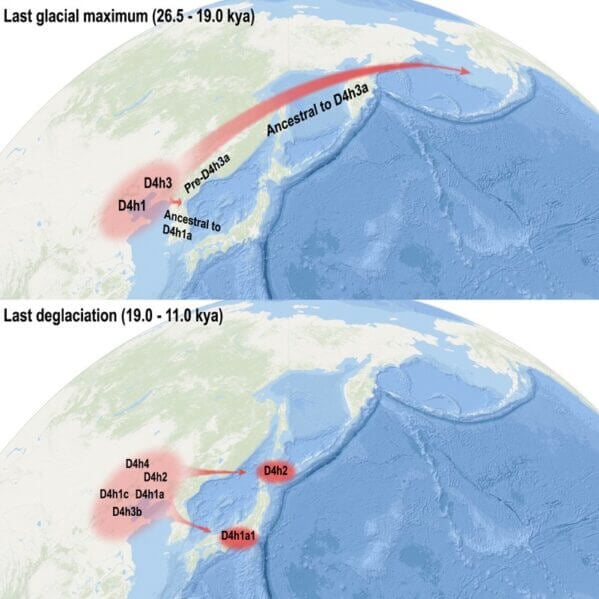- Scientists used mitochondrial DNA to trace a female blood line from northern coastal China to the Americas, showing the Asian ancestry of Native Americans is more complicated than we previously thought.
- Researchers ID’d at least two migration events from northern coastal China to the Americas, one during the last ice age and another during the subsequent melting period.
- The study found an unexpected genetic link between Native Americans and Japanese people, which helps explain Paleolithic archeological similarities between the Americas, China, and Japan.
Scientists have used mitochondrial DNA to track a female ancestral lineage, which originated from northern coastal China, to the Americas.
The team of researchers integrated contemporary and ancient mitochondrial DNA to find evidence of at least two migratory events, one during the last ice age and another in the following melting period. The findings suggest that around the same time as the second migration, another branch of the same lineage travelled to Japan. These discoveries may help explain the Paleolithic archeological similarities between China, Japan, and the Americas.
The study, published in the journal Cell Reports, shows that the Asian ancestry of Native Americans is more complex than previously thought.
“The Asian ancestry of Native Americans is more complicated than previously indicated. In addition to previously described ancestral sources in Siberia, Australo-Melanesia, and Southeast Asia, we show that northern coastal China also contributed to the gene pool of Native Americans,” explains first author Yu-Chun Li, a molecular anthropologist at the Chinese Academy of Sciences.
Previously, it was thought Native Americans were descended from Siberians who crossed the Bering Strait’s land bridge. But new genetic, geological, and archeological evidence suggest that multiple waves of humans migrated to the Americas from various parts of Eurasia.
The research team from the Chinese Academy of Sciences investigated the history of Native Americans in Asia by tracking the trail of an ancestral lineage, which could link East Asian Paleolithic-age populations to founding populations in California, Brazil, Bolivia, Chile, Ecuador, Mexico, and Peru. Mitochondrial DNA was used to trace the kinship through the female line.
More than 100,000 contemporary and 15,000 ancient DNA samples were collected from across Eurasia, with 216 contemporary and 39 ancient individuals eventually identified as belonging to the rare lineage. The lineage’s branching path was traced by comparing accumulated mutations, geographic locations, and carbon-dated age of each individual. The researchers identified two migratory events from northern coastal China to the Americas, with the travellers setting dock in America via the Pacific coast, rather than by crossing the inland ice-free corridor (which would not have opened at the time).
The first event occurred between 19,500 and 26,000 years ago during the Last Glacial Maximum, while the second event occurred between 19,000 and 11,500 years ago, during the subsequent deglaciation period. There was a rapid increase in human populations at this time, probably due to improved climate, which may have fuelled expansion into other geographical regions.
The researchers also found a surprising genetic link between Native Americans and Japanese people. Another group branched out from northern coastal China and travelled to Japan during the deglaciation period. “We were surprised to find that this ancestral source also contributed to the Japanese gene pool, especially the indigenous Ainus,” said Li.
The study focused on mitochondrial DNA, but complementary evidence from Y chromosomal DNA suggests that male ancestors of Native Americans also lived in northern China around the same time as these female ancestors.
This study adds more details to the complex puzzle that is Native American ancestry, but many aspects remain unclear. “The origins of several founder groups are still elusive or controversial,” said Kong. “Next, we plan to collect and investigate more Eurasian lineages to obtain a more complete picture on the origin of Native Americans.”
FAQ
Q: Can mitochondrial DNA be used to trace kinship through the male line?
A: No, mitochondrial DNA can only be used to trace kinship through the female line.
Q: How did the researchers identify the rare lineage?
A: The researchers scoured over 100,000 contemporary and 15,000 ancient DNA samples from across Eurasia to eventually identify 216 contemporary and 39 ancient individuals belonging to the rare lineage.
Q: What is the significance of the genetic link between Native Americans and Japanese people?
A: The genetic link between Native Americans and Japanese people provides unexpected insight into the Pleistocene connection among the Americas, China, and Japan, suggesting that this connection was not confined to culture but also to genetics.
Q: What do we still not know about the origin of Native Americans?
A: Many elements of Native American ancestry remain unclear, including the origins of several founder groups, and more research is needed to obtain a more complete picture of the origin of Native Americans.


